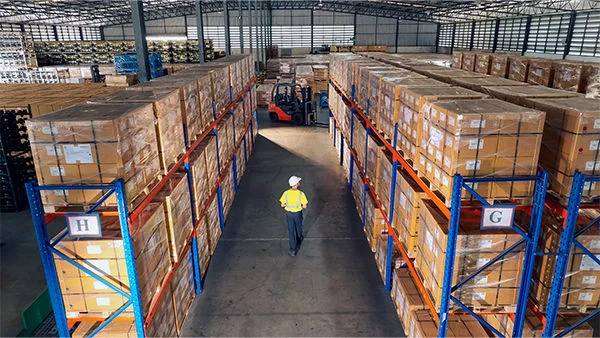Freight Density vs. Dimensional Weight: Understanding Shipping Costs
Whether you’re shipping less-than-truckload (LTL) or parcel, understanding what drives costs is critical to maintain efficiency and avoid unexpected charges. Two metrics stand out as major factors in shipping costs—freight density and dimensional weight (DIM weight). These metrics influence rates differently and knowing when and how they apply can help shippers optimize their shipping costs.
This article will clarify the differences between freight density and DIM weight, explain their role in shipping, and provide actionable strategies for reducing costs and preventing unexpected charges.
What Are Freight Density and Dimensional Weight?
Freight density and dimensional weight are two key factors that influence shipping rates, each focusing on different aspects of a shipment's size and weight.
Freight density is a physical measurement based on pounds per cubic foot. It is often used to determine the freight class in LTL. The formula for calculating density is total shipment weight (lbs.) divided by cubic feet. Our freight density calculator is an easy-to-use tool to help you calculate density.
For example, if a shipment weighs 500 pounds and occupies 10 cubic feet, the freight density would be 500 ÷ 10 = 50 pounds per cubic foot. This value is crucial for determining the applicable shipment’s class, which is published in the National Motor Freight Classification (NMFC).
Dimensional weight (DIM weight) is a volume measurement typically used for shipping parcels that calculates the amount of space a package uses, rather than its density.
DIM weight is calculated using package length × width × height and then dividing by a DIM Factor. Each parcel carrier sets their own DIM factor based on the type of shipment. The parcel carrier will compare the physical weight of the package and the DIM weight and use whichever weight is greater to impact your final bill. For example, if the DIM weight (100 pounds) is greater than the actual weight (e.g., 80 pounds), the carrier will use the DIM weight for pricing.
A parcel is a packaged shipment type typically consisting of a box, envelope, or other container used to transport goods or items. It is usually sent through a postal service, courier, or delivery company.
When and Why Each Metric Is Used in Shipping
In general, LTL carriers use freight density and parcel carriers use dimensional weight.
Shipment density is impacted by how the shipment is packaged. The packaging also affects how the shipment is handled and how LTL carriers load plan when transporting your shipment long distances.
LTL and parcel shipping methods are best suited for different types of shipments.
Use LTL shipping when:
- Shipping multiple boxes
- Shipment is palletized and ranges from 150 to 15,000 lbs.
- Regularly shipping similar orders
Use parcel shipping when:
- Shipping a single box
- Shipment is not palletized
- Submitting one-off orders
- You have residential customers
- Package meets carrier size and weight constraints
Generally, parcel carriers cannot accept shipments that weigh more than 150 pounds and meet certain dimensions. LTL carriers can typically handle shipments that are too bulky for parcel.
How Do Freight Density and DIM Weight Influence Pricing and Freight Classification?
In LTL shipping, density typically, but not always, determines the applicable freight classification. This provision in turn affects your LTL shipping rate. Generally, the denser a shipment is, the less expensive it is to ship. For more tips on LTL pricing, read our guide on best practices.
In parcel shipping, space rather than weight impacts the shipment’s pricing. DIM weight encourages package shippers to avoid oversized shipments by pricing them based on volume instead of weight. A lightweight yet bulky package can cost more than a smaller shipment of the same weight.
Regardless of the shipping method, it’s important to know the exact dimensions of your shipment, including packaging and any overhang on a pallet. Accurately measuring shipments can prevent unexpected charges. Carriers often check measurements and information provided on Bills of Lading (BOLs) or shipping papers and may increase final costs on the invoice if the measurements or information provided do not match. Common errors include giving an incorrect freight class, using incorrect weight estimates, or failing to account for packaging measurements as well as the measurements of the item being shipped. Accurate data is essential to avoid costly reclassifications or penalties.
What Are Some Strategies for Optimizing Shipments?
There are several strategies that LTL shippers can use to optimize freight density:
- Invest in dimensioners and regularly check weight scales for accuracy.
- When palletizing freight, use appropriately sized pallets that support all items.
- Minimize the amount of air or void space.
- Use NMFC best practices to manage oversized freight and consolidate shipments.
- If you notice classification changes on your BOL, check with your LTL carrier to see what they think has changed.
Parcel shippers using dimensional weight can use these best practices:
- Opt for durable yet compact materials that minimize wasted space.
- Select the correct box sizes and pack items snugly to reduce shipment volume.
Digital tools can also help shippers calculate freight density or DIM weight.
- Freight density calculators can help LTL shippers.
- Online volumetric calculators can help parcel shippers.
Although freight density and dimensional weight are used in different shipping methods, the takeaway is the same – use accurate measurements and proactively communicate with carriers. As an LTL shipper or a parcel shipper, using these actionable strategies can lower shipping costs, decrease unexpected billing discrepancies, and achieve greater operational efficiency.



